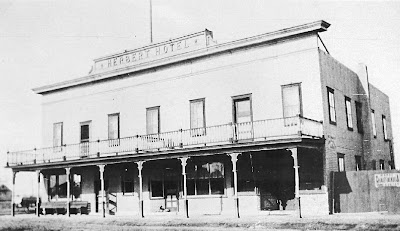 |
| Allan Hotel and Steak Pit, 2006. Joan Champ photo |
Peter J. Loehndorf was growing restless. In 1920, despite his rather impressive accumulation of seven quarters of land, plus one hundred and fifty head of cattle on his homestead near Leofeld, Saskatchewan, he was ready for a change. Perhaps his restlessness was due to the fact that he and his wife Maria had ten children, including two sets of twins. Every birth had necessitated another addition to the family’s log home since he had filed for the homestead in 1903. Then, in 1917, Peter’s father, John Loehndorf arrived from Germany to make his home with them. The thought of owning a hotel with lots of bedrooms must have appealed to Peter. In the spring of 1920, he sold his farm, bought the Hotel Allan, and moved in with his large family.
Hotel Allan had been built by Thomas Murphy in about 1910, and owned for several years thereafter by John Bitz and Tony Leier (who lost his life attempting to save a young child in the Elstow Hotel fire of 1919). In 1915, when the hotel business was no longer lucrative due to Prohibition, the Bitz family gave up the hotel and moved back to the farm.
 |
| Hotel Allan, c 1940. From Times Past to Present (1981) |
In 1936, changes in Saskatchewan’s liquor laws allowed Peter to open a beer parlour in Hotel Allan. It is quite likely that his wife, a deeply religious woman, did not approve. “Maria’s greatest comfort was the rocking chair and her faithful companion was the Rosary with which she prayed daily with sincere devotion,” the family’s history in Times Past to Present (Allan, 1981) explains. “Daily ritual required the family to recite meal prayers, morning and evening prayers.” Maria’s prayers may even have helped to save the Allan hotel from destruction by fire in 1935. “Fire ravaged building after building as it raced towards the hotel,” Allan’s history book records. “Women flocked to the church to pray. It was only through the tireless efforts of the fire brigade, and the prayers too, that the hotel came through with just one wall scorched.”
 |
| Peter and Maria Loehndorf, n.d. From Times Past to Present (1981) |
After the death of his father in 1923, Peter had been pursuing a new hobby – taxidermy. He had taught himself how to prepare, stuff and mount the skins of dead animals and birds – his sons’ hunting trophies – for display. People came from miles around to see his finished work which lined the walls of the beverage room in Hotel Allan.
In 1941, Peter added a live animal to his menagerie. During one of his trips to northern Saskatchewan, he captured a bear cub. To the amazement of the children of Allan, Peter kept the bear in a pen beside the hotel. A year later, the bear had grown so large and strong that it was dangerous. Peter’s solution was simple. “Bear meat being a delicacy, [the bear] was butchered and his meat distributed to various families around town,” the family history recounts. “Peter made up some summer sausage … and sent some of it to his son, Paul, who was still in England serving with the Canadian Armed Forces.” There is no mention of Peter applying his taxidermist skills to the bear's hide. Peter and Maria Loehndorf, both in their mid-70s, sold the Allan Hotel in 1946.
 |
| Allan Hotel and Steak Pit, 2006. Joan Champ photo |
When I stopped by the Allan Hotel in 2006, the wooden exterior of the Allan Hotel had been covered over with stucco and two layers of insulation. Nothing remained of Loehndorf's stuffed menagerie in either the 121-seat beverage room or the 32-seat restaurant on the main floor. The Allan Hotel was "semi-modern," with ten guest rooms on the second floor - three with sinks in the room. All shared a bathroom and shower, accessible from the hallway. The owners' two-bedroom living quarters was also located on the second floor.
Architectural History Society of Saskatchewan 3D Model Saskatchewan
© Joan Champ, 2011
View Larger Map

















































